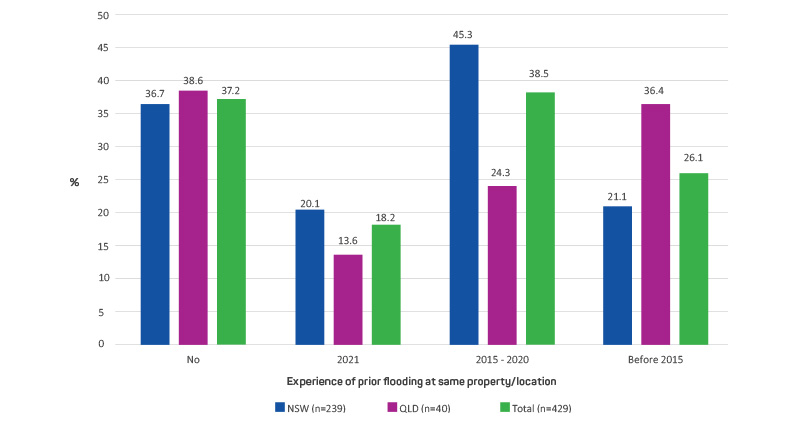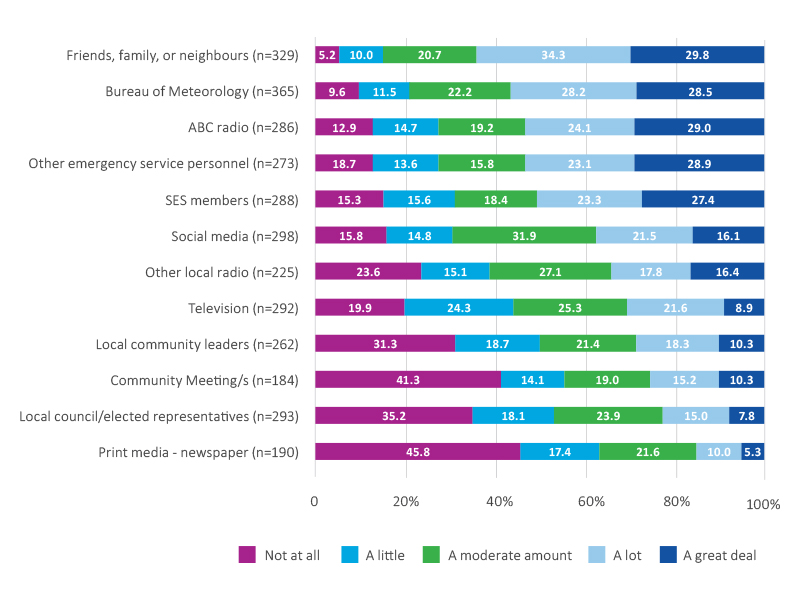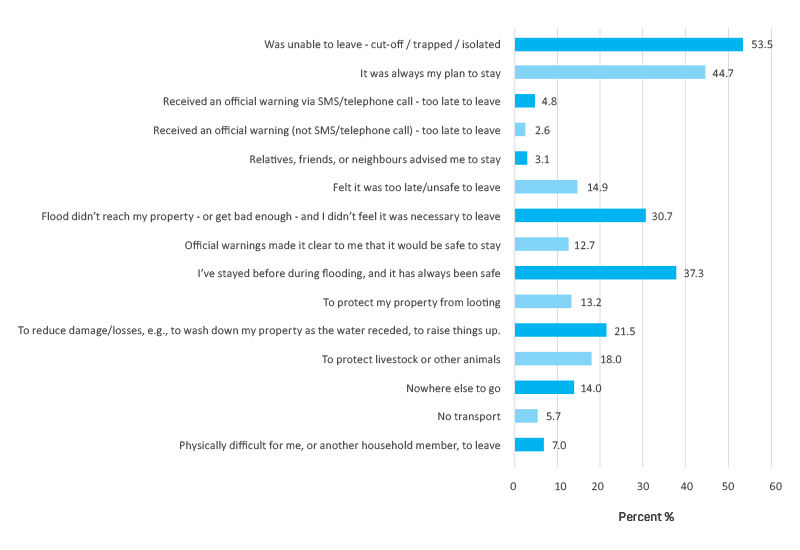Following a series of flooding events in New South Wales and Queensland during the period January to July 2022, Natural Hazards Research Australia funded a large post-event research project to understand and learn from the experiences of those affected. A major aim of the study was to identify insights of relevance to policy and practice across emergency management with a goal of using these findings to inform a broad set of stakeholder organisations and provide an evidence base to support future improvements in community safety in future severe natural hazard events. In-depth interviews were conducted between August and October 2021 with 194 residents affected by these floods. An online survey was completed by 430 flood-affected residents during the period November 2022 to February 2023. The data collected included details of prior flood exposure, damage or losses from the floods, information and warnings received, protective actions taken, decisions and actions taken during the flood and details about the clean-up, community and other sources of support as well as flood resilient adaptations made to homes before the floods and any future (planned) adaptations and actions. Three reports are available: a summary of policy implications, a main report detailing key findings and a technical report that includes summary data.
The 2022 floods in New South Wales and Queensland
Floods in eastern Australia in 2022 followed 2 years of above-average rainfall and, nationally, the wettest month on record was recorded in November 2021. This eventuated in extensive and damaging flooding that began in Queensland at the end of 2021 and in New South Wales in February 2022. Rain and severe flooding occurred again in late March and late June. These floods caused widespread devastation throughout communities, with some areas being flooded twice in only a few months, leaving inadequate time to recover or prepare from compound flooding. Further damage was done to eroded riverbanks, landslips, undercut roads and other essential infrastructure.
In response, Natural Hazards Research Australia conducted a large mixed-method, post-flood study of residents in Queensland and New South Wales focusing on people affected by flooding between January and July 2022. The aim was to hear and learn from the personal stories of people who were directly affected or threatened by floods. This project was conducted by researchers at Macquarie University, the University of Southern Queensland and Queensland University of Technology. Close research partnership throughout the process was provided by Queensland Fire and Emergency Services and the New South Wales State Emergency Service.
Trauma-informed community research
The project design followed an established post-event research approach (Natural Hazards Research Australia 2022) used by Australian researchers working in community-focused research after bushfires and floods (e.g. Haynes et al. 2018). Researchers interviewed 192 flood-affected residents (92 in Queensland and 100 in New South Wales) between August and October 2022 using a participant-led, trauma-informed approach that invited residents to ‘share their story’. A total of 430 residents (140 in Queensland and 290 New South Wales) participated in an in-depth online questionnaire between November 2022 and February 2023.
The online questionnaire was informed by the interview responses and included a mix of questions used in prior post-event research, as well as tailored questions. This mixed-method approach is a strength of this project. The qualitative interviews provide detail and richness about lived experiences, while analysis into themes allows for commonly reported experiences to be presented and reported succinctly. The quantitative questionnaire allows for identification of broader trends in the data and for statistical analysis to uncover relationships within the data.
Researchers investigated many themes with residents, including levels of preparedness and the role of prior flooding experiences to identify why some residents were more prepared than others, what actions they took in the lead up to and during the floods and the challenges they faced throughout the process. Participants were also asked how they received information and which sources were trusted. Researchers examined the types of housing that were flood damaged, any pre-flood modifications and the challenges posed in reconstruction under the threat of floods. The research assessed levels of satisfaction of participants with support provided by emergency services organisations and community service providers.
To enable initial summary reporting, qualitative data were coded to identify common themes in residents’ experiences. Quantitative data were summarised and subjected to simple statistical analysis. These findings have been included in the project main report (Taylor et al. 2023) and a summary report details the policy-relevant implications (Natural Hazards Research Australia 2023). A sample of findings are included here to exemplify the survey findings.
Flood ‘shock’ and contributing factors
The severity of the floods, especially those in late February and early March, was often referred to in the media and by those in authority as ‘unprecedented’. The flooding affected many areas that had been badly flooded previously, such as Maryborough, Gympie, suburbs of Brisbane, the Northern Rivers region, the Hunter and the Hawkesbury regions. Nearly two-thirds of participants in the survey (63%) had experienced floods previously; 18% recently, in 2021 (see Figure 1). These participants were, generally, engaged in and knowledgeable about local flooding. However, the severity of these floods was greater than expected and previously experienced, leaving people under-prepared and having to lift possessions ever higher as floodwaters rose or they expected to be safe when sheltering in place. In addition, a substantial proportion of the survey sample (37%) had not been flooded previously and many were not aware of being at risk of flooding. Some had been living in their properties for decades and experienced no flooding and, consequently, had no flood insurance. Both groups encountered a degree of flood ‘shock’.

Figure 1. Exposure to prior flooding at the same property/location and the timing of prior flooding (multiple responses permitted).
The challenges respondents encountered at the time of the floods and in the months following were exacerbated by several other interlinked factors, such as the scarcity of resources and access to professional and trades people caused by the extensiveness of the flooding (and subsequent flooding in other areas in 2022), supply shortages linked to the pandemic and the war in Ukraine as well as the rising costs of materials when rebuilding. At the time of the survey, around 10 months post-flood on average, more than half of the participants who had their homes damaged by the 2022 floods (55%) reported that everything was taking longer, 46% couldn’t get the trades or expertise they needed to help and 36% reported they weren’t coping well with the situation or managing what needed to be done.
The power of connection
An enduring finding across many areas of the study, in both interviews and the survey, was the importance of family, friends and neighbours. The highest levels of satisfaction with ‘support received’ was from friends and family, neighbours and the local community, with 87%, 84% and 78% of respondents, respectively, rating their satisfaction level with support from these sources as ‘extremely’ or ‘somewhat’ satisfied.
Friends, family and neighbours were important for alerting people to the flooding and 10% of respondents reported that they first found out they were likely to experience flooding from their family, friends or neighbours. This ranks second to participants who first found this out through observing the threat for themselves (30%). Friends, family and neighbours were also the groups most likely to provide help with the clean-up (82% of participants said they received help from these sources) and friends, family and neighbours were the most trusted sources of help in understanding the likely extent and location of flooding (see Figure 2). The power of connection and the importance of community for recovery has long been recognised in research and practice and operationalised in concepts such as social capital (Phoenix Australia 2022). This study expands on this evidence and situates it in a broad context of prior exposure, effects and events during and in the months after a disaster event.

Figure 2. Level of trust in difference sources for help in understanding the likely extent and location of flooding (n/a responses removed).
Sheltering in place - home as a port in the storm
Interviewees told their stories about decisions made and actions taken during the floods. Experiences differed greatly, with some waking up in floodwater or finding out too late that their home was inundated and that it was not possible to leave. Others had more time to prepare and act and although the flooding was generally worse than previously experienced, they were able to stay home and manage their situations.
In the survey, 61% of respondents sheltered in place or did not leave their home during the flood (30% left or self-evacuated and 9% were away from home and unable to return). Respondents provided many reasons for why they stayed (see Figure 3). In addition to those who had planned to stay or had stayed before (and presumably had been safe), many other reasons were given. Some stayed to reduce damage and get on with the clean-up quickly, to protect animals and to protect their property from looting. Others had more concerning reasons; it was too late or they were unable to leave, or they had nowhere to go, or had no transport or they or other household members had physical difficulties that made it hard to leave.
There was a range of different reasons but many encountered the same challenges. Three-quarters (75%) lost electricity, 52% lost communications, 39% lost sewerage and 32% were anxious about staying. Despite the challenges faced, 79% of respondents who stayed felt that it was the best decision.

Figure 3. Reasons respondents stayed during the flood (n=228) (multiple responses permitted).
What next
This research provided vital and valuable insights into community experiences of floods and will assist emergency management organisations, government departments, local councils and communities with a better understanding of the complexities of people’s experiences and perspectives before, during and after severe weather. The research team, along with Natural Hazards Research Australia, have been providing briefings and producing written outputs to ensure that the lived experiences of residents are heard and seen. Many participants in the study were motivated to take part because they wanted others to learn from their experiences and they wanted emergency management organisations to know the challenges they had faced or were still facing. The de-identified data from this study is a rich resource that can be interrogated and analysed for further insights.


